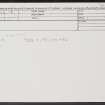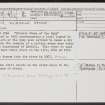Spey, 'miracle Stone'
Commemorative Stone (19th Century)
Site Name Spey, 'miracle Stone'
Classification Commemorative Stone (19th Century)
Canmore ID 15392
Site Number NH91NW 18
NGR NH 9499 1966
Datum OSGB36 - NGR
Permalink http://canmore.org.uk/site/15392
- Council Highland
- Parish Abernethy And Kincardine
- Former Region Highland
- Former District Badenoch And Strathspey
- Former County Inverness-shire
'The source behind much of Arthur Mitchell's account was a local farmer and Free Church supporter, James Cameron, who lived at Wester Tullochgribban. He corresponded with and met Sir Arthur. Cameron published several very rare pamphlets on the stone now held by Inverness Library in their Charles Fraser Mackintosh collection.'
[Email from Louise Yeoman (BBC Edinburgh) to Caroline Torres (RCAHMS), 10 August 2012].
'[George Dixon] actually went into the river to look for it [in 1964], armed with Sir Arthur Mitchell's sketch, and found the main fragment lying at an angle in the sandy bed of the Spey with cut lettering still on it - he felt the letters with his finger, but couldn't photograph it, as it was underwater.'
[Email from Louise Yeoman (BBC Edinburgh) to Caroline Torres (RCAHMS), 13 August 2012].
The date (1964) of George Dixon's investigation derives from an interview with him that was broadcast on the BBC Radio Scotland programme, 'Past Lives' (Series 16, Episode 5), 14 September 2012.
Information from RCAHMS (ATW), 11 March 2016.
NH91NW 18 9499 1966
NH 9499 1966 "Miracle Stone of the Spey" A stone erected in 1865 commemorating a local legend in which the waters of the Spey were divided to cause a dry passage whereby the remains of a certain woman were taken across to the churchyard of Duthill. This event is said variously to have taken place in the 13th, 16th or 17th centuries. The stone was thrown into the river in 1867.
A Mitchell and J Drummond 1875.
This stone still exists in the river close to the bank below where it stood.
Information from G A Dixon, 13 Thirlestane Road, Edinburgh to OS 25 November 1970.
Change Of Classification (16 April 2018)
The classification was change from 'Stone' to 'Commemorative Stone' after the available evidence was re-assessed.
Information from HES Survey and Recording (JRS) 16 April 2018.
Field Visit (22 March 2018)
Nothing is now visible of this stone, which was erected on the crest of the steeply sloping N bank of the River Spey in 1865 (Inverness-shire - Mainland XLVI.14, 1873). The contemporary Name Book (Inverness-shire No. 24, p. 33) records that an inscription on the slab read ‘Erected at the request of the late William Grant Slock for a memorial of a signal manifestation of the divine power in dividing this water and causing a passage whereby the remains of a certain woman was carried over on dry ground’. There is an illustration of the stone and some detail of its background story in the chapter entitled ‘XV. Holy Mary of Lurg’ in ‘In the Shadow of Cairngorm’ by the Rev. W Forsyth, published in 1900. This is available in digital format at https://archive.org/details/inshadowcairngo00forsgoog (website accessed 16 April 2018).
The slab was broken up and thrown into the river in 1867, but its location in the water was confirmed in 1964. The water was cloudy and up to 1m deep at this point on the date of visit and no fragments of the monument were observed.
Visited by HES, Survey and Recording (ATW) 23 March 2018.










